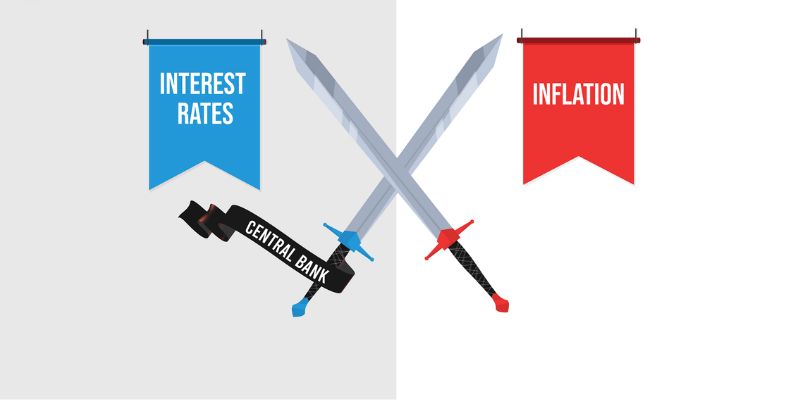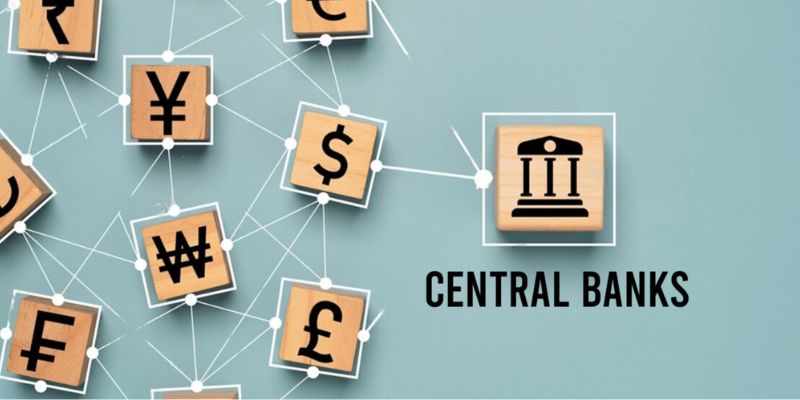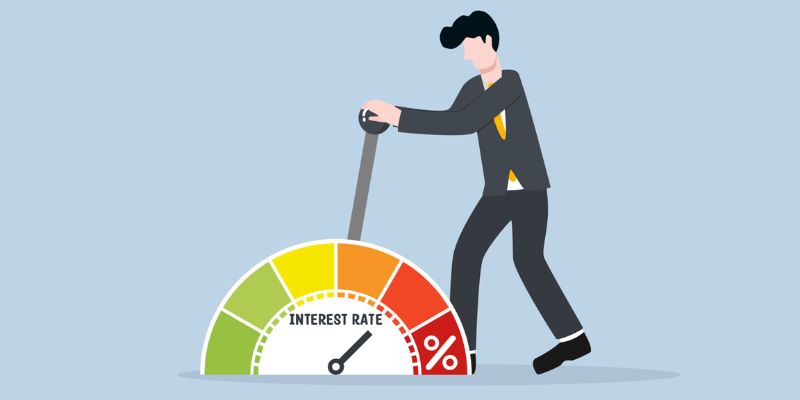Central bank interest rates and inflation may seem like dry topics, but hear me out—they’re your pocket’s unsung heroes. Picture this: prices soaring, your shopping cart gets pricier by the minute. Here’s where the central bank swoops in, wielding interest rates like a finely-honed shield against the inflation dragon. Think they can’t make a real dent? Walk with me through the inner workings of monetary policy and see how these levers pull the strings of the economy. Together, let’s demystify how rate tweaks can cool down a red-hot cost of living or jump-start a sluggish investment scene. Ready to get clear on how your cash stays king in a wobbly market? Let’s dive in.
Understanding Central Bank Monetary Policy and Inflation Dynamics
The Mechanism Behind Interest Rate Hikes and Economic Impact
When central banks change interest rates, they’re like superheroes. They fight a sneaky villain – inflation. Inflation makes things pricier. So, to tame it, these banks hike rates. This makes borrowing costlier. People then borrow and spend less. As demand drops, prices stop rising so fast. It’s a key way banks keep prices stable.
Exploring the Spectrum of Monetary Policy Tools
Central banks have many tools, not just interest rate hikes. They use the cash rate – what banks pay to borrow from each other. By changing it, they influence the whole economy. The cash rate sways savings, loans, and how much cash businesses have. It’s a tricky balance, but the right tweaks keep inflation in check. Lower rates can make businesses invest more. But if rates stay low for too long, too much cash chases too few goods. Then, prices can shoot up again.
They also use the discount rate. It’s what banks pay to borrow directly from the central bank. When central banks tweak this rate, they send a signal. It tells us if they are worried or relaxed about the economy’s health.
Repo rate is another cool tool. It’s a bit complex, but let’s break it down. Banks sometimes need quick cash. So they sell securities to a central bank but agree to buy them back later. It’s very short-term. The rate they pay back, the repo rate, influences other rates across the economy.
Then there’s quantitative easing. When central banks use it, they become big buyers. They buy a ton of government bonds. This pumps money into the economy, lowering interest rates. It’s like a big cash wave that lifts all boats. But it must be done just right. Otherwise, it can cause more inflation, not less.
Central banks use these tools aiming for a sweet spot. They balance between prices not rising too fast (inflation) and not falling (deflation). Central banks’ inflation targets are like their mission goals. Most aim for a small, steady inflation rate. This helps them make sure our money doesn’t lose value too fast or too slow.
So what happens when banks nail this balance? It’s golden. We see steady prices, more jobs, and a growing economy. But when it tips too far? That’s when the economy can get sick – with too much inflation or even deflation.
Think of inflation like a balloon. We want it just right. If it’s too big, it could pop – that’s like hyperinflation, really bad. If it’s too small, it’s not fun – like deflation, where prices fall and no one wants to spend.
The central bank’s role in the economy is huge. They watch the economy like guardians. Always ready to jump in, with their monetary policy tools, if things go wacky. They tweak interest rates, pump or pull back money, all to keep us going steady. Like superheroes, their fight is never over. But with their keen eye on inflation, growth, and our cash, we can sleep a little easier, knowing they’re on it.

The Real Effects of Interest Rate Adjustments on Economic Growth
Dissecting the Relationship Between Interest Rates and Inflation
Interest rates are like a superhero’s mighty tool, fighting the sneaky villain – inflation. Think of your central bank as a superhero team. Their job is to keep prices from flying too high too quickly. If things cost too much, families have a tough time buying what they need.
The team has a special power – the interest rate. When they turn it up, like a dial, borrowing cash gets more costly. People and businesses say, “Hmm, maybe we’ll spend less.” When folks spend less, prices tend to stop racing up. This way, central banks keep inflation in check.
If the team sets rates too high, though, it’s trouble. Money becomes too pricey to borrow, and people stop spending. If they overdo it, they could slow the economy right down. It’s a fine line they walk, making sure they’ve got it just right.
Interest Rates and Their Role in Influencing Unemployment and Investment
Now, let’s zoom in on jobs and money-spending on big things, like houses or machines. Lower interest rates are like a green light. They tell people and companies, “Go ahead, borrow money, and make things happen!” Businesses might build new stores or make more products, and they need workers to do that. Hi there, new jobs!
But wait, there’s more to the story. When interest rates are low for a long time, people worry. They think, “Will prices shoot up? Should I save my money instead?” This could lead to less spending and even less investing. That’s not what our central bank heroes want.
They keep a close eye on things. If jobs are hard to find or too many are out there, they adjust their interest rate weapon. They aim for the sweet spot where people have work, but prices aren’t jumping all over the place.
In their secret lair of economy protection, the central bank watches every move. They want you to have a job and be able to pay for what your family needs. But they also want to make sure that a loaf of bread doesn’t end up costing as much as a spaceship. They balance things out, using their interest rate superpowers just right.
In the world of money, it’s all about balance. Central banks are the guardians. They use interest rates to make sure we can live, work, and play without the trouble of soaring prices or job worries. They aim for that perfect balance so we can all thrive. Keep watching, because the next time rates change, it’s the central banks moving their chess pieces for our good.

Navigating Inflation Control Strategies and Targets
How Central Banks Use Interest Rates to Manage Inflationary Pressures
Imagine superheroes who fight a sneaky villain named Inflation. These heroes are central banks, and their main weapon is the interest rate. When prices start to climb, the bank swings into action. It can raise interest rates to cool things down. This makes borrowing money cost more. People and businesses then spend less, and this helps stop prices from rising too fast.
Interest rates and economic growth are like a seesaw. When rates go up, borrowing costs rise, slowing growth a little. When rates drop, borrowing is cheaper, so businesses invest and hire more, and people buy more stuff. But if banks drop rates too much, it can backfire and prices may leap up too high.
Central banks shoot for just-right inflation, not too hot or cold. This “Goldilocks” level keeps the economy humming without prices zooming up. Each bank has a target, often around 2%. They check on prices and jobs to see if they should bump rates up or down.
Quantitative Easing and Tightening: Timing and Effectiveness
There’s also a tool called quantitative easing, or QE for short. When times are rough and cutting interest rates isn’t enough, banks use QE. They buy things like government bonds with new money. This helps lower interest rates even more, which encourages spending and helps keep people in jobs.
But QE is a big gun that can’t be used all the time. Central banks must pick the right time to use it. They watch the market, prices, and how folks feel about the economy. If timing’s off, it won’t help much, like wearing a raincoat in the sunshine.
Tightening is when banks do the opposite of QE. They sell off assets or raise interest rates to soak up extra money. They do this when the economy’s too hot and prices race up. It’s like tapping the brakes on a car that’s speeding.
Central banks are there to keep the economy steady. By making smart moves with interest rates, they help keep jobs, savings, and spending on track. They’re the unsung heroes in the fight against too-high or too-low inflation. They make sure our money stays strong and we can keep living our lives without price chaos.

The Future Outlook: Interest Rates and the Health of the Economy
Interpreting Central Bank Policy Statements and Inflation Forecasts
When central banks talk, we listen. They give clues. We get what they will do with interest rates soon. They aim to keep prices stable. They don’t want them to go up or down too fast. We watch their policy statements. They tell us their next moves. We want to know – ‘Will interest rates go up? Or down?’.
Central banks have a magic number. It’s their inflation target. They want prices to rise just enough, not too much. If prices climb too fast, they hike interest rates. This brings spending down and helps cool off inflation.
Now, how do we know if they’re on track? We look at forecasts. They predict future prices. It’s like a weather forecast but for money. This helps us see if a cash rate change is coming. It tells us how the economy might do.
Forecasting isn’t perfect, though. That’s why central banks also watch what’s happening right now. They look at the consumer price index (CPI). It’s a basket of goods and prices. It says if life is getting costly. They tweak rates to keep the CPI steady.
Assessing the Risk of Hyperinflation and the Tools to Prevent It
Nobody wants prices to explode. When they do, it’s hyperinflation. It’s bad. Money loses value fast. People can’t afford stuff. Think of it like a fire, and interest rate hikes are the water. The central bank throws them on to put the fire out. They’ve got other tools too. They can use what’s called ‘tightening monetary policy’.
Tightening means they make it hard to get loans. It’s like turning off a tap. Less money flows. People spend less, borrow less, and prices slow down.
Then there’s quantitative easing. Think of it as a money pump. It puts cash into the economy when things are slow. But it’s a careful balance. You don’t want to pump too much.
Repo rate has power too. It’s what banks pay to borrow money. Make it high; banks lend less. This can also cool down a hot economy.
Interest rates and growth are buddies. Get the balance right, and the economy grows. Get it wrong, and things can go bad. We want to get that balance right.
Forecasting what central banks will do, looking at the economy now, and planning for what if prices surge — these things matter. We’ve got to keep one eye on today’s prices and one eye down the road. It helps us to stay ready for what comes next.
Central banks guide the ship. Their choices make waves in our wallets. They fight inflation so we can plan for tomorrow. Their reports on inflation trends and the central bank’s role in the economy are our maps.
Hyperinflation is a monster, but we’ve got heroes. They come armed with interest hikes, repo rates, and tight money policies. These tools keep the economy safe and sound. They’re on watch, and so are we.
In this post, we’ve explored how central banks use tools like rate hikes to manage the economy. We’ve seen that interest rates impact everything from inflation to job numbers. These adjustments aim to keep growth steady and prices in check. We learned that finding the right balance is tough, but crucial for economic health. Looking ahead, we must keep an eye on bank policies and inflation signs to predict our financial future. Banks work to dodge hyperinflation, using every tool they have. Your grasp on these concepts can help you understand and react to economic changes. Stay informed, stay prepared. That’s how you stay ahead in today’s economy.
Q&A :
How do Central Bank Interest Rates Affect Inflation?
Central bank interest rates, commonly known as the benchmark or policy rates, are crucial in managing inflation within a country. When a central bank increases interest rates, borrowing becomes more expensive, which can slow down spending and investment, thus cooling off economic activity and reducing inflation. Conversely, when interest rates are lowered, it stimulates borrowing, spending, and investment, potentially leading to higher inflation if the economy overheats.
What Role Does the Central Bank Play in Controlling Inflation?
The central bank is pivotal in shaping monetary policy, with its primary objective often being the control of inflation. By setting the interest rates at which commercial banks can borrow from them, central banks can influence the money supply and the overall economic activity. Central banks may set inflation targets and adjust interest rates to steer inflation towards those targets, ensuring price stability and fostering sustainable economic growth.
Can Interest Rate Changes Impact Consumer Prices Directly?
Interest rate changes by central banks do not directly alter consumer prices, but they do influence economic factors that can lead to changes in these prices. Higher interest rates may reduce consumer borrowing and spending, which can lead to lower demand for goods and services, potentially reducing their prices. On the other hand, lower interest rates may encourage spending, which can increase demand and, consequently, prices.
How Quickly do Interest Rate Decisions Influence Inflation?
The effect of interest rate decisions on inflation does not occur instantaneously. It can take several months to a couple of years for changes in central bank interest rates to fully permeate the economy and affect inflation. This lag is due to various factors, including the time it takes for monetary policy decisions to influence consumer behavior, investment decisions, and other macroeconomic factors.
What Are the Risks of Keeping Interest Rates Low for an Extended Period?
Keeping interest rates low for an extended period can pose several risks. It may lead to excessive borrowing and debt accumulation, asset bubbles due to increased investment in search of higher returns, and potentially higher inflation if the economy overheats. Additionally, it can limit the central bank’s ability to further lower rates in response to future economic downturns, as rates cannot fall much below zero.

